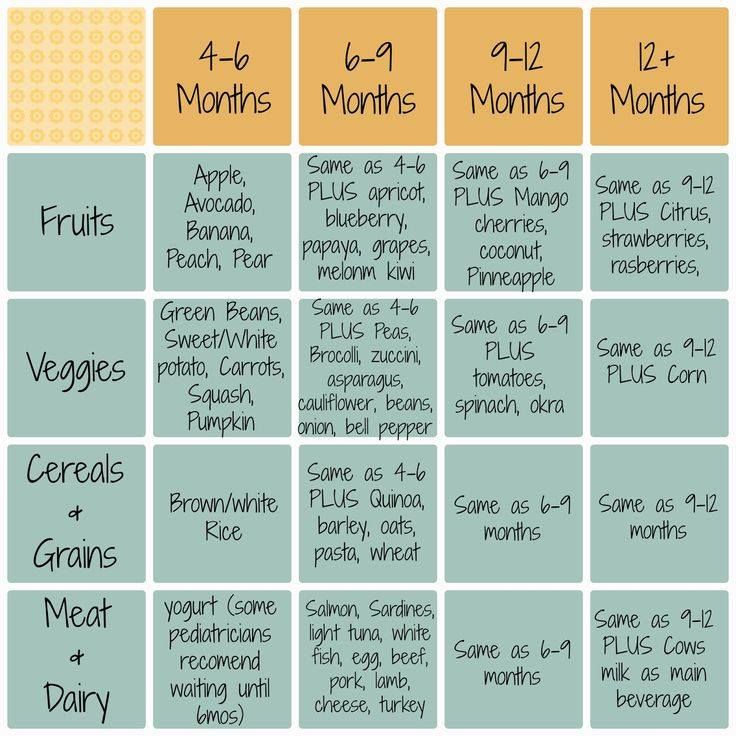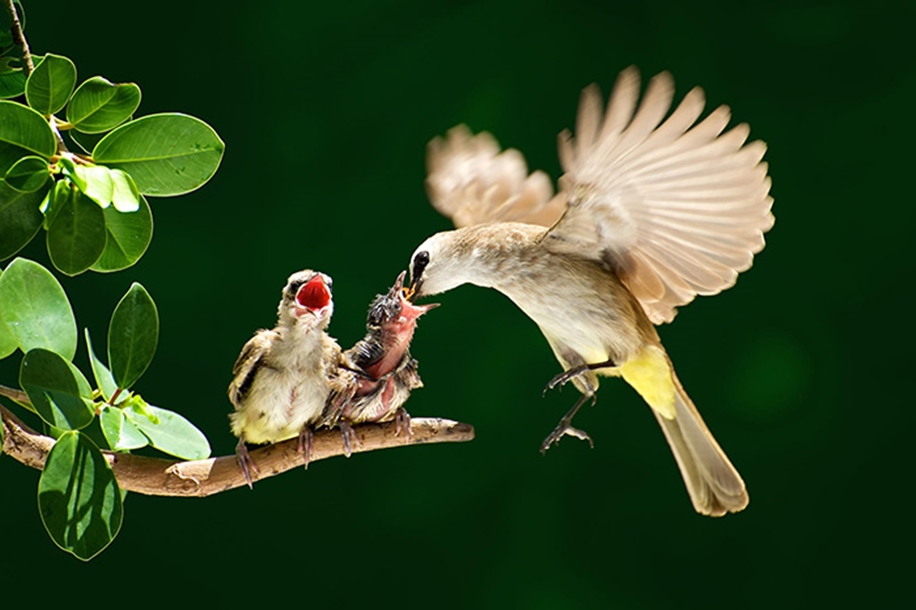Homemade baby quail food
5 Easy Homemade Baby Quail Food Recipes: You NEED To Try
Your baby quail is all grown up! They’re no longer a tiny newborn but an adolescence-ready, featherless friend that needs to be fed.
How to Feed a Baby Bird - When to F...
Please enable JavaScript
How to Feed a Baby Bird - When to Feed a Baby Bird
Feeding your little bird can seem daunting at first, and there are many things you need for him or her in what they eat.
Rule number one in how to raise baby quail school, is “feed them the right food!
Homemade baby quail food recipes are a great way to provide your little feathered friends with the nutrients they need.
Plus, you can avoid dangerous chemicals and artificial flavors!
In this blog post, we’ll discuss 5 easy homemade baby quail food recipes that will keep them healthy in order for their immune systems to stay strong during birdhood development stages.
Table Of Contents
- 5 Homemade Baby Quail Food Recipes
- How to Make the Formula (Step-by-Step Instructions)
- How To Feed The Formula To Your Baby Quail
- How To Preserve The Formula
- Cheapest Way to Feed Quail Chicks
- FAQ
The following recipes are hand-feeding formulas that can be fed to your baby quail up to two times a day.
Trending
Can Scarlet Macaws Talk?
It is recommended you use non-medicated feeder insects.
These include insects like:
- crickets,
- fireflies,
- worms,
- etc.
This is once they are weaned or coming towards the end of the weaning process, and will help your quails get the nutrients they need.
The following homemade recipes will enable your baby quail to grow quicker and wean sooner, in addition to developing a brighter and more vibrant color.
We suggest providing fresh water and food at all times, and monitoring your chicks for any signs of illness such as weakness, stunted growth or lethargy.
When it comes to the dry ingredients, such as ground oats and wheat, we typically use our eyes when determining quantities because you’ll want to change the recipe based on what you have in your pantry and what your bird prefers.
If you are worried about whethe or not your baby quail will take to the food, don’t be!
They aren’t fussy eaters, and will be ecstatic as long as you give him or her good, complete sources of protein and fats, and avoid foods that it should not eat!
Getting The Ratios Right
Baby quails require a large amount of protein (20%) and fat (15%) within their diets. They also need calcium and phosphorus, but with a 15:1 calcium to phosphorus ratio.
Calcium is very important at all stages of development, especially with the breeding mother, as it aids in eggshell-hardening and muscle contractions such as breathing and embryonic development.
With this in mind, any homemade baby quail food recipes should include calcium sources.
Without further ado, here are our 5 easy, great-tasting, and healthy homemade baby quail food recipes that you can cook up anytime!
1) Ground Oat, Boiled Egg (whole), Cornmeal, Coconut OilCornmeal is ideal for your little bird because it is already ground and provides a tasty alternative to whole grains. Coconut oil, along with the egg yolk, gives your baby quail healthy fats that help them grow.
Coconut oil, along with the egg yolk, gives your baby quail healthy fats that help them grow.
Boiled eggs have a good amount of protein and fat, and the eggshell is a great calcium source!
The ground oats also provides your little bird with fiber and carbohydrates as well as minerals such as calcium, magnesium, potassium, and iron.
2) Ground Corn, Ground Oats, Dried Beets & Chia SeedsIn this recipe, the dried beets and chia seeds will give your quail the extra protein, fat, and fiber it needs.
Ground oats provide carbs as well as protein and some fat as well as minerals such as calcium, magnesium, potassium, and iron.
Ground corn also gives your baby quails carbs along with zinc and niacin.
Dried beets also provide minerals such as calcium, magnesium, potassium, and iron.
3) Ground Corn, Ground Barley, Poppy Seeds, Whole Egg & Flaxseed Meal
This is one of my favorite homemade baby quail food recipes. In this recipe, the poppy seeds provide your baby quail with calcium as well as potassium, phosphorus, and magnesium.
In this recipe, the poppy seeds provide your baby quail with calcium as well as potassium, phosphorus, and magnesium.
The whole egg is hardboiled and provides protein and calcium.
Flaxseed meal is rich in the following:
- Vitamin E,
- manganese,
- copper,
- fiber,
- Omega-3 fatty acids,
- lignans,
- ]antioxidants ,
- hemicellulose ,
- proteins ,
- iron ,
- phosphorous ,
- magnesium,
- zinc,
- and fiber.
Plus it’s a good source of calcium as well!
Ground barley is rich in carbohydrates as well as selenium and phosphorus.
4) Ground Brown Rice, Dried Peas (or raw pea protein), Dried/Ground Sunflower SeedsThe rice in this recipe provides a good source of vitamins and minerals for your baby quail, such as the naturally occurring Vitamin B.
Peas are also included which provide protein while fiber can help keep them feeling full!
Some birds do not like eating raw peas so if yours seems immune then try replacing it with arrowroot powder instead; just remember that all recipes containing ground brown rice will eventually lead to digestive issues unless replaced by another carbohydrate ingredient such quinoa or barley flour.
In this recipe, the soy protein provides female baby quails with calcium and omega-3 fatty acids while it helps to aid in plucking in male birds. It also assists to reduce aggressive behavior such as biting and fighting.
The ground oats provide carbohydrates that will eventually be turned into glucose within your bird’s body.
The flaxseed provides Vitamin E, manganese, copper, fiber, Omega-3 fatty acids, lignans, antioxidants , hemicellulose , proteins , iron , phosphorous , magnesium, zinc, and fiber. Alfalfa meal is also rich in calcium.
How to Make the Formula (Step-by-Step Instructions)
We recommend that you only use one of these at a time and see how your baby quail likes them. All of these recipes make for a complete and balanced meal.
- Combine all ingredients in a blender and process until it is a fine crumble
- Add some water to the mixture if needed.
 If your quail mix needs moistening, use hot water.
If your quail mix needs moistening, use hot water. - Include some cuttlebone for them to gnaw on as well as their regular bird seed mix
- Sprinkle this mix into their housing whenever they need feeding or
- Place them in a high-speed blender for 30-60 seconds until you have a smooth (not thick and sticky) consistency.
- Feed your baby bird!
We also recommend adding some bird vitamin drops to your homemade formula for a vitamin boost. This should be added to the individual feed and not the entire batch, so you can manage how much you are giving your quail at any given feed.
If you have quite a busy schedule, it can be quite time-consuming to make your own baby bird feed. No worries, we’ve got you covered. This high-fat, nutrient-dense hand-feed formula will do just as well.
How To Feed The Formula To Your Baby QuailThe baby bird feeding syringes are the “least messy” way to feed your little one. These curved tips make it easy for you, as they’ll go right into their mouth!
You can also use a spoon if need be but there might not always remain enough space between two teeth where I’ve seen fit put all my efforts into getting just once piece inside so that’s why using this method may take longer than expected (though not necessarily bad!).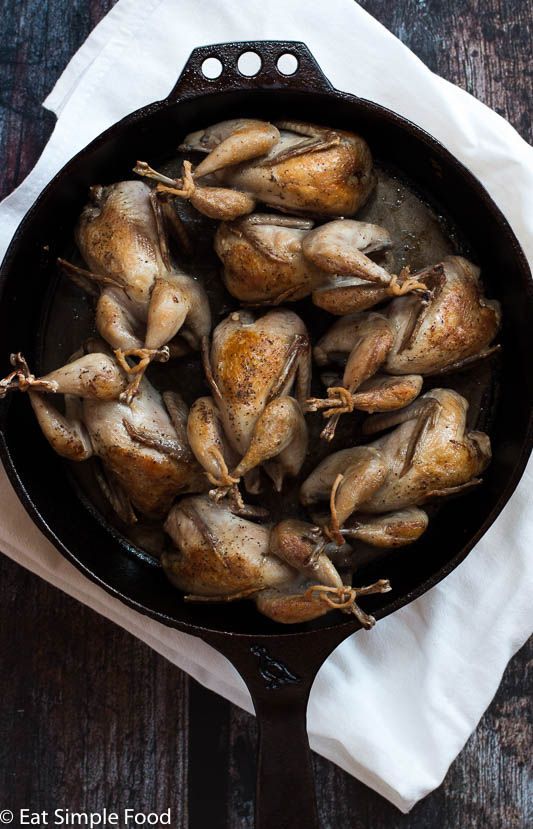
If you have used any wet ingredients, you will need to seal the leftover formula in an airtight container and store it in the fridge.
Although you may not mind leaving some out for them to finish later on, this is not recommended due to the high risk of bacterial growth; also make sure they eat any leftovers before you leave again!
If all dry ingredients were used, you can place any excess formula in an airtight container and store it in the freezer for up to six months.
Cheapest Way to Feed Quail Chicks
If you decide that homemade formula prep life just isn’t for you, it’s okay; you have options!
FAQCan Baby Quail Eat Baby Food?
No. Baby quails cannot eat baby food.
What Do Baby Quails Eat?
Older baby quails can safely eat seed, insects and grasshoppers. When they are old enough to leave the nest they learn to feed themselves by foraging with their parents in nearby grasslands away from predators where the parents can defend them better. A wild quail diet consists of seeds, green plants, and insects.
A wild quail diet consists of seeds, green plants, and insects.
Can I Make My Own Baby Bird Food?
Yes, you can easily make your own baby bird food by following these instructions on how to prepare homemade quail food. But before you do, please be aware of the potential hazards involved with this if you are not extremely careful about cleanliness and contamination.
Can Baby Quail Eat Dog Food?
Again, no. Some pet stores will try to recommend dog food as an alternative because it is cheaper; however, dog food lacks the proper nutrition and ingredients that quail need for proper growth.
Do Baby Quails Need To Be Hand-Fed?Newborn quails who do not have their mother to feed them do need to be hand-fed their formula.
This is just to ensure that they are getting the nutrients and energy that their bodies need to grow and develop properly.
What Do I Do If My Quail Is Not Eating?
Quails tend to be fussy eaters, so there is a chance that they will not want to eat any of your homemade formula or hand-feeds right away. Don’t worry! If you follow these hand-feeding tips, your baby quail should be eating before you know it!
Don’t worry! If you follow these hand-feeding tips, your baby quail should be eating before you know it!
Do Baby Quails Need Vitamin Drops?
If you’re making your own quail food (such as the 5 easy homemade recipes listed above), then vitamin drops are completely optional. It’s always a good idea to toss some in for good measure, but you can always talk to your veterinarian for more information.
how long can baby quail go without food
Baby quails, also known as chicks, can typically survive without food for up to 24-48 hours after hatching, as they absorb nutrients from the yolk sac that remains attached to their body.
Homemade Quail Feed - Little Red Acres
- Share
- Tweet
If you're a quail farmer, or even if you just have a few quail as backyard pets, you know that finding the perfect feed can be difficult. But what if we told you that you could make your own homemade quail feed right at home?
This post contains affiliate links, see my disclosure policy for more information.
Homemade Quail Feed
We'll show you how to do just that. With a few simple ingredients, you can create a nutritious and delicious quail feed that will keep your birds healthy and happy.
I am not an expert, not a vet, I am not going to guarantee this for your quail. But it is an option for feeding your birds. I do buy feed at this time for all of our birds.
To make quail food, the ingredients should contain protein, carbohydrates, fat, fiber, and minerals.
Granivores have a diet that consists mainly of grains and seeds. However, this does not mean that they won’t eat the kind of things that most birds enjoy, like bugs, worms, and plant matter.
Homemade Quail Feed Recipes
I found two different recipes you are welcome to try. I think both of these options are probably more to make than buying a bag of feed from your local feed supply store. Personally, we have NOT made our own feed like this, and I have no plans to do so at this point.
Option #1:
- 27kg maize
- 15kg fish mineral
- 35kg wheat
- 15kg cotton seed cake
- 3kg oil
- 0.3kg methionine
- 0.4kg lysine
- 1kg DCP powder
- 2.8kg calcium carbonate
- 0.25kg multivitamins
- 0.25kg minerals
Option #2:
- 410lbs corn
- 480 lbs soybean
- 110lbs wheat middlings
- 8lbs limestone
- 4lbs salt
- 20lbs dicalcium phosphate
- 1.5lbs dl methionine
- 2.5lbs vitamin premix
- 1.0lbs mineral premix
Other Options for Homemade Quail Feed
These are both ways to help reduce the cost of feeding your quail, not by any means a way to remove having a feed in their diet.
Growing fodder is another great way to create your own source of food for your quail. It is low cost because you can grow it from just about anything. You'll want to have a good setup where you consistently have fodder on hand for your birds.
Mealworm farming is another way to have a feed supply for your birds. You can Google how to do this. My oldest gave this a try but we didn't stick with it for long.
- Share
- Tweet
Ashley Mullen
Ashley is a stay-at-home homeschooling mom, turned homesteader, living in Canada. I have been homeschooling for years and love it. Now my children and I get to learn about and help others homeschool and be able to provide for their families and teach our children about where their food comes from.
Similar Posts
types of feed, diet and norms
Quail meat and eggs are healthy dietary products. They contain a large amount of easily digestible protein, practically do not cause allergies and have a delicate taste. It is profitable to breed quails, since finished products are in consistently high demand among buyers. Regardless of the method of keeping quails (agro-complex, farming, home conditions), it is necessary to take care of the proper feeding of quails, starting from the 1st day of life and until the moment of slaughter. The health of the entire livestock, growth rate, slaughter weight and egg production depend on the quality of nutrition.
The health of the entire livestock, growth rate, slaughter weight and egg production depend on the quality of nutrition.
Content:
- Quail food varieties
- Feed formulations
- Features of the diet of birds of different ages
- Breeders' recommendations for feeding meat quails
- Peculiarities of feeding laying quails
- Advantages of prepared feeds
Quail food varieties
Mixtures containing all the ingredients necessary for birds are considered complete. Such feeds are marked with the abbreviation PC.
| PK-11/ DK-50 | Mixes for chicks. They contain chalk, wheat, corn, a small amount of salt. For their enrichment with proteins, soybean meal is used, as well as meat and bone or fish meal. Serving volumes depend on age, but do not exceed 27 g per day per chick. |
|---|---|
| DK-52 | They form the basis of the diet of adults and laying quails. Compound feed contains 60% of cereals (mainly barley, oats, corn, wheat), as well as 30% of animal proteins (from fish meal) and laboratory-synthesized lysine. To increase egg production, 5% of minerals (phosphates, chalk, salts) are introduced. To increase the calorie content, bran and wheat flour are used as fillers. Compound feed contains 60% of cereals (mainly barley, oats, corn, wheat), as well as 30% of animal proteins (from fish meal) and laboratory-synthesized lysine. To increase egg production, 5% of minerals (phosphates, chalk, salts) are introduced. To increase the calorie content, bran and wheat flour are used as fillers. |
Feed formulations
| Cereals |
|
|---|---|
| Legumes |
|
| succulent feed |
|
| Crop processing products |
|
| Components of animal origin |
|
| Vitamin and mineral supplements |
|
The type of food for is selected taking into account the age of the quail and the conditions in which they are kept.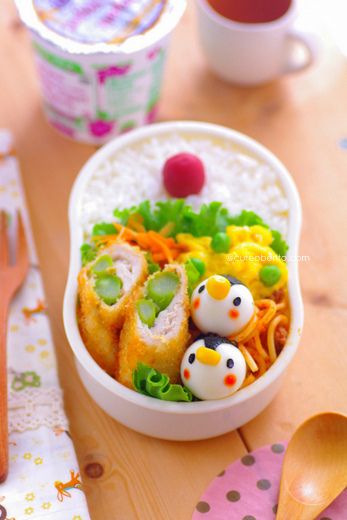 In small farms or complexes with their own raw material base, it is more profitable to prepare feed mixtures on their own and enrich them with concentrated protein-vitamin-mineral supplements (PVMD). At large enterprises, it is more convenient to use ready-made complete feed containing all the necessary components.
In small farms or complexes with their own raw material base, it is more profitable to prepare feed mixtures on their own and enrich them with concentrated protein-vitamin-mineral supplements (PVMD). At large enterprises, it is more convenient to use ready-made complete feed containing all the necessary components.
Features of the diet of birds of different ages
On the first day of life, quails can only be given boiled, finely chopped eggs. The next day, cottage cheese is introduced in the amount of 2 g for each chick. On day 3, the chicks are offered fresh greens. Especially useful are onions, dandelions or young nettles. Starting from day 4, the content of boiled eggs in the feed gradually decreases, but the amount of cottage cheese increases.
Week-old quails can already be fed boiled fish, millet and finely grated vegetables, including carrots. However, in the first weeks it is advisable to use ready-made feed mixtures that are appropriate for age.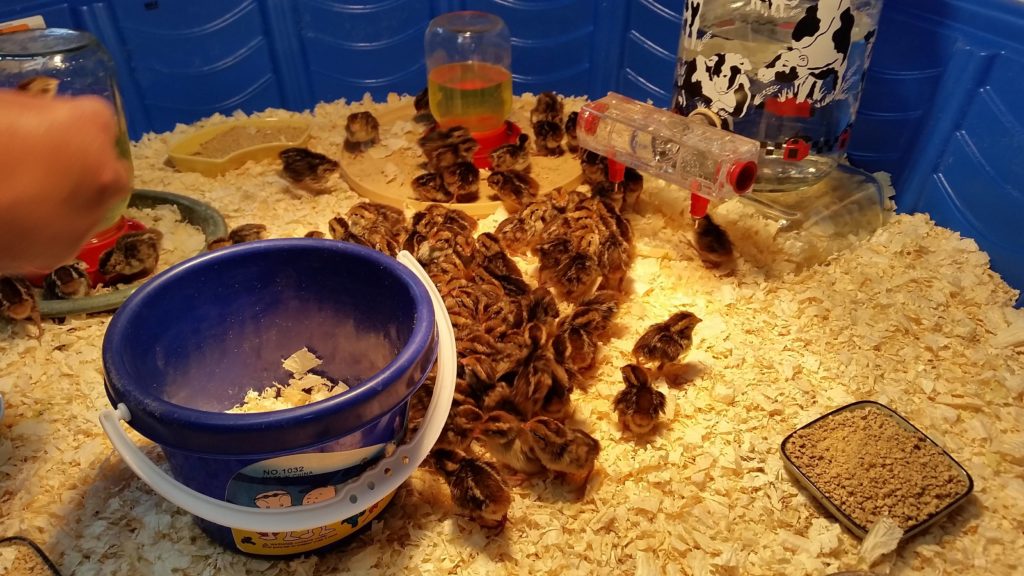 Such compositions belong to the starting ones. For laying hens, a special compound feed is produced with the marking Dk-52. To prevent beriberi, it is recommended to give vitamin supplements to chicks from 5–6 days.
Such compositions belong to the starting ones. For laying hens, a special compound feed is produced with the marking Dk-52. To prevent beriberi, it is recommended to give vitamin supplements to chicks from 5–6 days.
Chicks from 14 to 28 days can be transferred to ready-made complete feed containing 24-26% proteins. At this stage, quails are actively growing, so they have an increased need for protein. With its shortage, the diet of chicks is recommended to be further enriched with products of animal origin, for example, include cottage cheese or boiled fish in it. To prevent vitamin deficiency, increase the amount of fresh herbs. From day 14, fine gravel or shells can be added to the feed to stimulate the digestion process.
Additionally, it is useful for quails to give cabbage leaves, lettuce, spinach, parsley, clover, beet tops, alfalfa, stems of legumes. Greens are thoroughly crushed before adding to the mixer. Monthly young animals are gradually transferred to the main feed for quails.
Particular attention should be paid to the nutrition of females who are just starting to lay eggs. To strengthen their health, the amount of vitamin supplements is increased during this period. In laying hens, the need for vitamins A and E increases by 50%.
If, at the initial stage of female maturation, it is necessary to delay egg laying, most of the grains that are responsible for the formation of eggs are removed from the diet, and the protein content is reduced to 15%.
Chicks are gradually transferred to adult food at the age of 30–42 days. At this stage, it is enough to feed them three times a day. When developing a recipe, it is important to take into account the effect of grains and proteins on the speed of puberty and increase / decrease their amount to speed up / slow down the process. Meat breeds are given PK-6 compound feed, which stimulates a rapid set of muscle mass.
The consumption of nutrients by the body of birds in different seasons of the year and under different environmental conditions is not the same, this must be taken into account when compiling feed mixtures and determining the daily allowance.
A feature of feeding quails in the summer is an increase in the amount of fresh greens consumed per day. When bred in a private home, birds also have the opportunity to feed on insects or earthworms. In the conditions of a poultry farm, protein of animal origin is available to them only as part of the feed.
In winter, instead of fresh greenery, grass harvested from the summer is used. In the absence of natural vitamins at this time, feed mixtures should be enriched with special additives.
An important element for the drinking regime of any animal is the origin of water. When using water from a well, it should be heated each time, otherwise the birds may catch a cold.
Breeders' recommendations for feeding meat quails
All chicks must have easy access to drinkers. It is important to renew the water daily.
Meat quails are fattened gradually. With a sharp transition to specialized mixtures and an increase in portions, the gastrointestinal tract of the bird does not have time to adapt.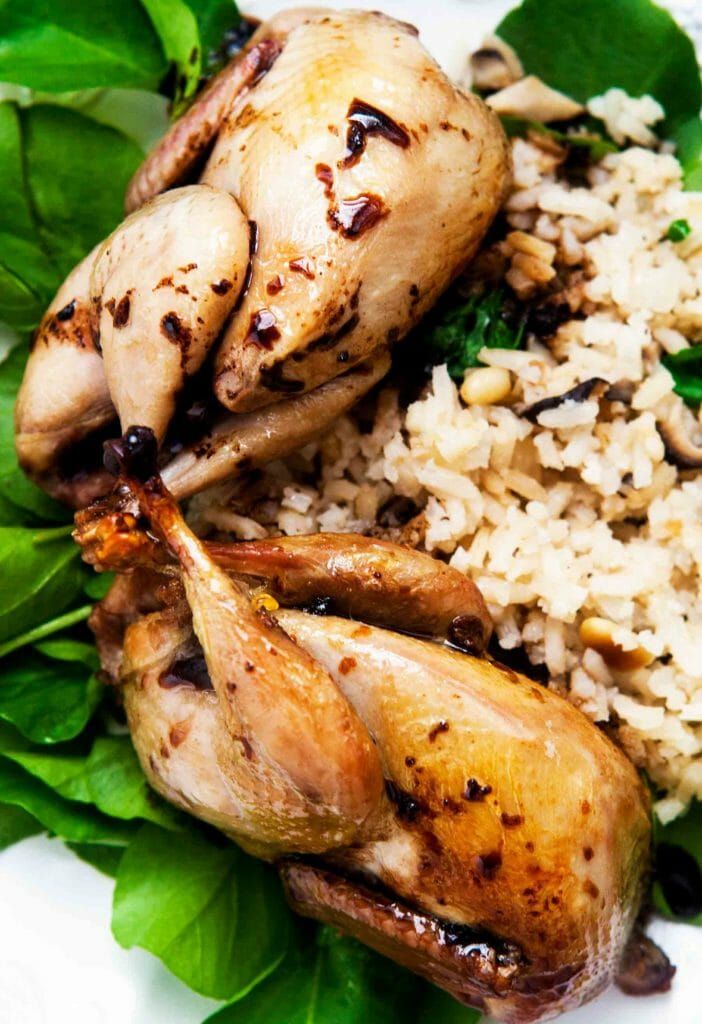 High risk of indigestion.
High risk of indigestion.
On average, the transition takes 4 days. At first, the serving volume remains the same as for adult birds, but the percentage of fat and starchy corn in the diet increases. The fattening process takes about a month.
Quails are placed in cages with solid walls and placed in a shaded area. Males should be kept separate from females. When fattening, quail feeding rates are taken as for an adult bird, while the amount of corn and fat increases. Fattening continues up to four weeks.
In the last week, the daily food intake is increased by 8%. If an individual receives a balanced diet, its weight by this time is at least 160 g. To improve the taste of meat, fish, onions, garlic are removed from the diet a few days before slaughter and chopped carrots are added. It gives the final product a richer color. It is not recommended to include products with a pronounced smell in the diet of birds at the fattening stage.
In carcasses of category 1, muscle tissue is well developed. There are deposits of subcutaneous fat on the chest and abdomen. Category 2 meat is classified if the muscle tissue is developed satisfactorily. Subcutaneous fat deposits may be absent.
There are deposits of subcutaneous fat on the chest and abdomen. Category 2 meat is classified if the muscle tissue is developed satisfactorily. Subcutaneous fat deposits may be absent.
Peculiarities of feeding laying quails
For egg breeds, it is important to select balanced mixtures with high nutritional value. To increase the productive period, quails need to consistently receive a certain amount of proteins, fats, carbohydrates, vitamins, micro and macro elements. They require feed with a protein content of at least 20.5%. This is a prerequisite for improving egg quality and egg production.
In addition, it is useful to add crushed eggshells to the mixture to replenish calcium losses in laying hens. One bird requires 25–30 g of feed daily. However, an excess of protein is undesirable, since quails begin to lay eggs with two yolks. Excess calories are also bad. Birds gain fat and stop laying eggs.
Advantages of prepared feed
In the production of safe balanced mixtures for quails, it is important to monitor the quality of raw materials and the correct ratio of ingredients. In small and medium-sized farms, it is difficult to organize the technological process in compliance with all standards. Acquisition of a special production line, laboratory checks, arrangement of storage facilities with certain parameters of temperature and humidity require significant costs. It is much more profitable to buy ready-made mixtures from a reliable manufacturer.
In small and medium-sized farms, it is difficult to organize the technological process in compliance with all standards. Acquisition of a special production line, laboratory checks, arrangement of storage facilities with certain parameters of temperature and humidity require significant costs. It is much more profitable to buy ready-made mixtures from a reliable manufacturer.
The MEGAMIX company is engaged in the development of recipes and the production of feed for quails of all ages:
- grains, legumes, herbs grown in the Kuban are used as raw materials;
- our products fully comply with state standards and are stored in proper conditions;
- you buy safe food with high nutritional value;
- the company has an extensive dealer network and organizes deliveries throughout the country.
Our experts will tell you in detail how to feed meat quails and laying hens, what product norms should be laid down at each stage of cultivation, how best to care for birds in order to increase the profitability of their breeding.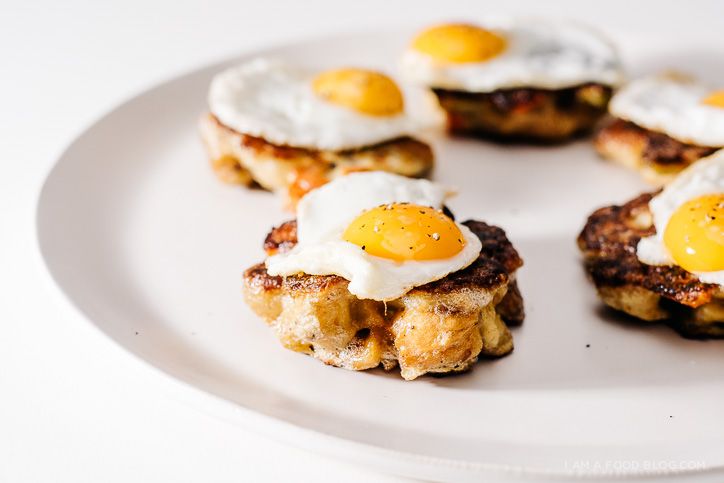
How to feed quails at home
Quail meat and eggs are useful dietary products. They contain a large amount of easily digestible protein, practically do not cause allergies and have a delicate taste. Quail breeding is profitable, since finished products are in consistently high demand among buyers. However, in order to increase the profitability of a poultry farm or farm, it is important to provide birds with the right nutrition throughout their life cycle. The health of the entire livestock, growth rate, slaughter weight and egg production depend on the composition and quality of the feed.
Content:
- Quail food varieties
- Feed formulations
- Features of feeding birds of different ages
- Breeders' recommendations for feeding quails
- Advantages of prepared feeds
Quail food varieties
Mixtures containing all the ingredients necessary for birds are considered complete. Such feeds are marked with the abbreviation PC and a number indicating the purpose.
| PK-11/ DK-50 | Chick formulas. They contain chalk, wheat, corn, a small amount of salt. For their enrichment with proteins, soybean meal is used, as well as meat and bone or fish meal. Serving volumes depend on age, but do not exceed 27 g per day per chick. |
| DK-52 | They form the basis of the diet of adults and laying hens. The feed mixture contains 60% cereals (mainly barley, oats, corn, wheat), as well as 30% animal proteins (from fish meal) and laboratory-synthesized lysine. To increase egg production, 5% of minerals (phosphates, chalk, salts) are introduced. To increase the calorie content, bran and wheat flour are used as fillers. |
Feed formulations
| Cereals (oats, wheat) | These products are high in B vitamins and trace elements. Oats are recommended as the basis of the diet. Before adding to the feed, it is necessary to remove the husk from it, therefore, only peeled and sifted grain is used in ready-made mixtures. |
| Corn | It is the most important source of carbohydrates. It is useful to give it in combination with meat and bone or fish meal, since corn itself does not have enough protein, but there is a lot of starch. |
| Legumes | Rich in proteins and amino acids, as well as valuable fatty acids. For the preparation of feed mixtures, soybeans, lentils, peas, etc. are used. |
| Animal Products | To saturate the feed with essential amino acids, meat and bone and fish meal are added to it. Both ingredients can be administered alternately or mixed. Another source of animal proteins, micro and macro elements are cottage cheese and whey. |
| Minerals | To stimulate digestion in quails, crushed solid particles are specially added to the feed mixtures. Most often, shells, chalk, egg shells, and gravel are used for these purposes. |
Features of the diet of birds of different ages
On the 1st day of life, chicks can only be given boiled, finely chopped eggs. The next day, cottage cheese is introduced in the amount of 2 g for each chick. On the 3rd day, the chicks are offered fresh greens. Especially useful for them are onions, dandelions or young nettles. Starting from the 4th day, the content of boiled eggs in the feed gradually decreases, but the amount of cottage cheese increases.
The next day, cottage cheese is introduced in the amount of 2 g for each chick. On the 3rd day, the chicks are offered fresh greens. Especially useful for them are onions, dandelions or young nettles. Starting from the 4th day, the content of boiled eggs in the feed gradually decreases, but the amount of cottage cheese increases.
Week-old quails can already be fed boiled fish, millet and finely grated vegetables, including carrots. However, in the first weeks it is advisable to use ready-made feed mixtures that are appropriate for age. Such compositions belong to the starting ones. For laying hens, a special compound feed is produced with the marking Dk-52. To prevent beriberi, it is recommended to give vitamin supplements to chicks from 5-6 days (usually quails are soldered with chiktonik).
From the 14th to the 28th day, chicks can be transferred to ready-made complete feed containing 24-26% proteins. At this stage, quails are actively growing, so they have an increased need for protein. If it is deficient, it is recommended to further enrich the diet of chicks with products of animal origin, for example, include cottage cheese or boiled fish in it. To prevent vitamin deficiency, increase the amount of fresh herbs. From the 14th day, fine gravel or shells can be added to the feed to stimulate the digestion process.
If it is deficient, it is recommended to further enrich the diet of chicks with products of animal origin, for example, include cottage cheese or boiled fish in it. To prevent vitamin deficiency, increase the amount of fresh herbs. From the 14th day, fine gravel or shells can be added to the feed to stimulate the digestion process.
Additionally, it is useful for quails to give cabbage leaves, lettuce, spinach, parsley, clover, beet tops, alfalfa, stems of legumes. Greens are thoroughly crushed before adding to the mixer. Monthly young animals are gradually transferred to the main feed for quails. Particular attention should be paid to the nutrition of females who are just starting to lay eggs. To strengthen their health, the amount of vitamin supplements is increased during this period. In laying hens, the need for vitamins A and E increases by 50%. If, at the initial stage of maturation, the female needs to delay egg laying, most of the grains that are responsible for the formation of eggs are removed from the diet, and the protein content is reduced to 15%.
Chicks are smoothly transferred to adult food at the age of 30-42 days. At this stage, it is enough to feed them three times a day. When developing a recipe, it is important to take into account the effect of grains and proteins on the speed of puberty and increase / decrease their amount to speed up / slow down the process. Meat breeds are given PK-6 compound feed, which stimulates a rapid set of muscle mass.
Breeders' recommendations for feeding quails
All chicks must have easy access to drinkers. It is important to renew the water daily. In the first 3 days, it must be boiled and disinfected with potassium permanganate (just add a couple of crystals). Then you can limit yourself to only boiling.
Meat quails are fattened gradually. With a sharp transition to specialized mixtures and an increase in portions, the gastrointestinal tract of the bird does not have time to adapt. High risk of indigestion. On average, the transition takes 4 days.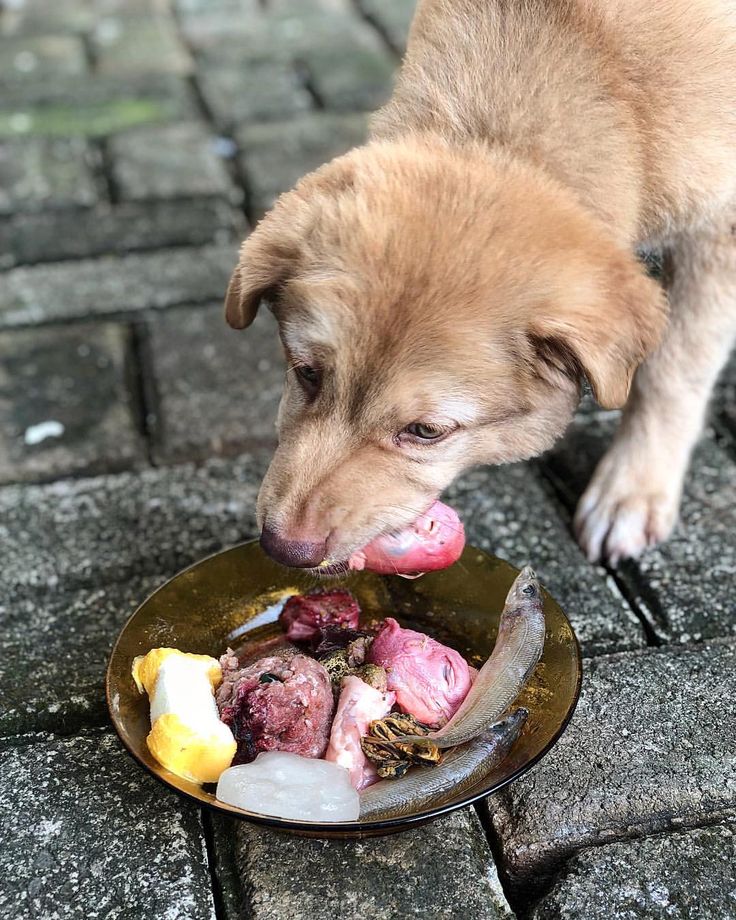 At first, the serving volume remains the same as for adult birds, but the percentage of fat and starchy corn in the diet increases. The process of fattening quails takes about a month.
At first, the serving volume remains the same as for adult birds, but the percentage of fat and starchy corn in the diet increases. The process of fattening quails takes about a month.
In the last week, the daily food intake is increased by 8%. If an individual receives a balanced diet, its weight by this time is at least 160 grams. To improve the taste of meat, a few days before slaughter, fish, onions, garlic are removed from the diet and chopped carrots are added. It gives the final product a richer color. It is not recommended to include products with a pronounced smell in the diet of birds at the fattening stage.
For egg-bearing breeds, it is important to select balanced mixtures with high nutritional value. To increase the productive period, quails need to consistently receive a certain amount of proteins, fats, carbohydrates, vitamins, micro and macro elements. They require feed with a protein content of at least 20.5%. This is a prerequisite for improving egg quality and egg production. In addition, it is useful to add crushed eggshells to the mixture to replenish calcium losses in laying hens. One bird requires 25-30 g of feed daily. However, an excess of protein is undesirable, since quails begin to lay eggs with two yolks. Excess calories are also bad. Birds gain fat and stop laying eggs.
In addition, it is useful to add crushed eggshells to the mixture to replenish calcium losses in laying hens. One bird requires 25-30 g of feed daily. However, an excess of protein is undesirable, since quails begin to lay eggs with two yolks. Excess calories are also bad. Birds gain fat and stop laying eggs.
Advantages of prepared feeds
In the production of safe balanced mixtures for quails, it is important to monitor the quality of raw materials and the correct ratio of ingredients. In small and medium-sized farms, it is difficult to organize the technological process in compliance with all standards. Acquisition of a special production line, laboratory checks, arrangement of storage facilities with certain parameters of temperature and humidity require significant costs. It is much more profitable to buy ready-made mixtures from a reliable manufacturer.
The company "Southern Crown" is engaged in the development of recipes and the production of feed for quails of all ages:
- ❖ cereals, legumes, herbs grown in the Kuban are used as raw materials;
- ❖ our products fully comply with state standards and are stored in proper conditions;
- ❖ you buy safe food with high nutritional value;
- ❖ The company has an extensive dealer network and organizes deliveries throughout the country.



 It can replace succulent herbs in winter.
It can replace succulent herbs in winter.  Rich in proteins, vitamins and mineral salts. Must be crushed first. As an analogue, you can use fishmeal.
Rich in proteins, vitamins and mineral salts. Must be crushed first. As an analogue, you can use fishmeal. 



